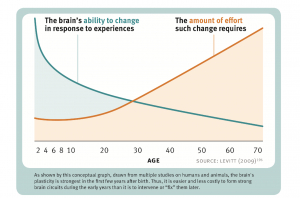Neuroplasticity
From BurnZero
Neuroplasticity is the ability of the brain to change its default activity in response to intrinsic or extrinsic stimuli by reorganizing how it works by modifying its connectivity.
The brain is neurochemical in nature i.e. part chemical hormones and part electric circuitry. When these combine they work like hiking trails. The ones that get a lot of traffic get smoother and wider, with brush stomped down and pushed back. The neural pathways that sit unused grow over, becoming less likely to be used. Your brain uses the more accessible pathways as it takes lower energy to do so. Humans lose their neuroplasticity as they age[1] (see figure 1). Recent studies have shown this change can be reversed by types of shock.
References
- ↑ Changes in plasticity across the lifespan: Cause of disease and target for intervention. Accessed on 3rd March 2022, via https://www.ncbi.nlm.nih.gov/pmc/articles/PMC4392917/
